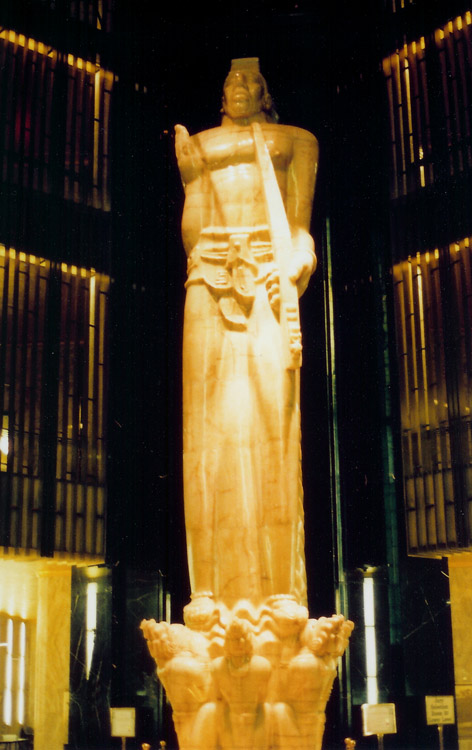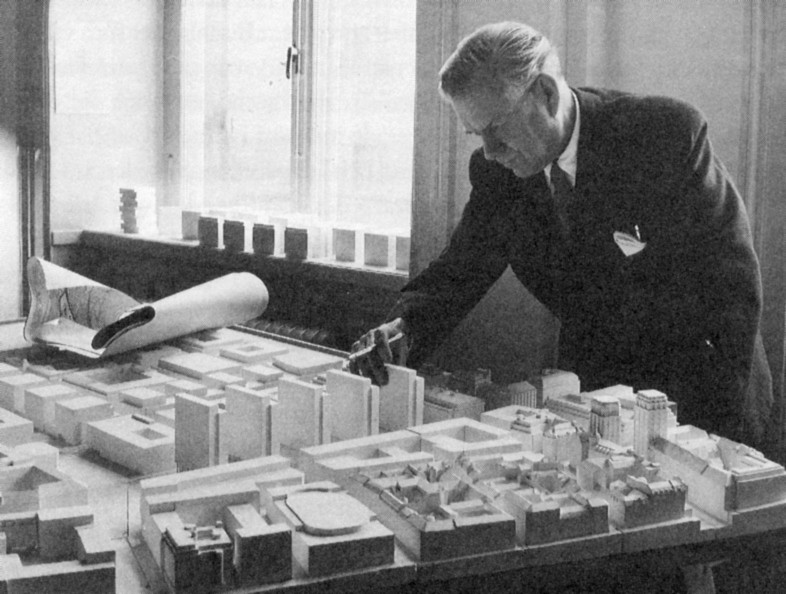|
Hillevi Svedberg
Hillevi Svedberg (1910–1990) was an early Swedish female architect whose work was inspired by Functionalism. She is remembered for introducing showers and bathrooms in working-class housing and for her low-cost collective housing developments with children's care centres. One of her most successful buildings was the Yrkeskvinnornas Kollektivhus or YK-House (1939) in Stockholm's Gärdet district which she designed in collaboration with Albin Stark (1885–1960). Early life Born on 20 December 1910 in Uppsala, Hillevi Svedberg was the daughter of the Nobel chemistry laureate Theodor Svedberg and the physician Andrea Andreen. Her brother Elias Svedberg (1913–1987) was an interior designer. She studied architecture at Stockholm's Royal Institute of Technology, graduating in 1933. Only very few Swedish women had studied architecture as until 1921, it was only available for men. On 29 June 1933, she married the engineer Knut Robert Knutsson Almström (1907–1980). Career Imme ... [...More Info...] [...Related Items...] OR: [Wikipedia] [Google] [Baidu] |
Eliel Saarinen
Gottlieb Eliel Saarinen (, ; August 20, 1873 – July 1, 1950) was a Finnish-American Architecture, architect known for his work with art nouveau buildings in the early years of the 20th century. He was also the father of famed architect Eero Saarinen. Life and work in Finland Saarinen was educated in Helsinki at the Helsinki University of Technology. From 1896 to 1905 he worked as a partner with Herman Gesellius and Armas Lindgren at the firm Gesellius, Lindgren, Saarinen. His first major work with the firm, the Finnish pavilion at the Exposition Universelle (1900), Paris 1900 World Fair, exhibited an extraordinary convergence of stylistic influences: Finnish wooden architecture, the British Gothic Revival, and the Jugendstil. Saarinen's early manner was later christened the Finnish National Romantic Style, National Romanticism and culminated in the Helsinki Central railway station (designed 1904, constructed 1910–14). From 1910 to 1915 he worked on the extensive city- ... [...More Info...] [...Related Items...] OR: [Wikipedia] [Google] [Baidu] |
Swedish Architects
Swedish or ' may refer to: Anything from or related to Sweden, a country in Northern Europe. Or, specifically: * Swedish language, a North Germanic language spoken primarily in Sweden and Finland ** Swedish alphabet, the official alphabet used by the Swedish language * Swedish people or Swedes, persons with a Swedish ancestral or ethnic identity ** A national or citizen of Sweden, see demographics of Sweden ** Culture of Sweden * Swedish cuisine See also * * Swedish Church (other) * Swedish Institute (other) * Swedish invasion (other) * Swedish Open (other) {{disambig Language and nationality disambiguation pages ... [...More Info...] [...Related Items...] OR: [Wikipedia] [Google] [Baidu] |
1990 Deaths
Year 199 ( CXCIX) was a common year starting on Monday (link will display the full calendar) of the Julian calendar. At the time, it was sometimes known as year 952 '' Ab urbe condita''. The denomination 199 for this year has been used since the early medieval period, when the Anno Domini calendar era became the prevalent method in Europe for naming years. Events By place Roman Empire * Mesopotamia is partitioned into two Roman provinces divided by the Euphrates, Mesopotamia and Osroene. * Emperor Septimius Severus lays siege to the city-state Hatra in Central-Mesopotamia, but fails to capture the city despite breaching the walls. * Two new legions, I Parthica and III Parthica, are formed as a permanent garrison. China * Battle of Yijing: Chinese warlord Yuan Shao defeats Gongsun Zan. Korea * Geodeung succeeds Suro of Geumgwan Gaya, as king of the Korean kingdom of Gaya (traditional date). By topic Religion * Pope Zephyrinus succeeds Pope Victor I, as ... [...More Info...] [...Related Items...] OR: [Wikipedia] [Google] [Baidu] |
1910 Births
Year 191 ( CXCI) was a common year starting on Friday (link will display the full calendar) of the Julian calendar. At the time, it was known as the Year of the Consulship of Apronianus and Bradua (or, less frequently, year 944 ''Ab urbe condita''). The denomination 191 for this year has been used since the early medieval period, when the Anno Domini calendar era became the prevalent method in Europe for naming years. Events By place Parthia * King Vologases IV of Parthia dies after a 44-year reign, and is succeeded by his son Vologases V. China * A coalition of Chinese warlords from the east of Hangu Pass launches a punitive campaign against the warlord Dong Zhuo, who seized control of the central government in 189, and held the figurehead Emperor Xian hostage. After suffering some defeats against the coalition forces, Dong Zhuo forcefully relocates the imperial capital from Luoyang to Chang'an. Before leaving, Dong Zhuo orders his troops to loot the tombs of the Ha ... [...More Info...] [...Related Items...] OR: [Wikipedia] [Google] [Baidu] |
Franklin D
Franklin may refer to: People * Franklin (given name) * Franklin (surname) * Franklin (class), a member of a historical English social class Places Australia * Franklin, Tasmania, a township * Division of Franklin, federal electoral division in Tasmania * Division of Franklin (state), state electoral division in Tasmania * Franklin, Australian Capital Territory, a suburb in the Canberra district of Gungahlin * Franklin River, river of Tasmania * Franklin Sound, waterway of Tasmania Canada * District of Franklin, a former district of the Northwest Territories * Franklin, Quebec, a municipality in the Montérégie region * Rural Municipality of Franklin, Manitoba * Franklin, Manitoba, an unincorporated community in the Rural Municipality of Rosedale, Manitoba * Franklin Glacier Complex, a volcano in southwestern British Columbia * Franklin Range, a mountain range on Vancouver Island, British Columbia * Franklin River (Vancouver Island), British Columbia * Franklin Strai ... [...More Info...] [...Related Items...] OR: [Wikipedia] [Google] [Baidu] |
Frank Lloyd Wright
Frank Lloyd Wright (June 8, 1867 – April 9, 1959) was an American architect, designer, writer, and educator. He designed more than 1,000 structures over a creative period of 70 years. Wright played a key role in the architectural movements of the twentieth century, influencing architects worldwide through his works and hundreds of apprentices in his Taliesin Fellowship. Wright believed in designing in harmony with humanity and the environment, a philosophy he called organic architecture. This philosophy was exemplified in Fallingwater (1935), which has been called "the best all-time work of American architecture". Wright was the pioneer of what came to be called the Prairie School movement of architecture and also developed the concept of the Usonian home in Broadacre City, his vision for urban planning in the United States. He also designed original and innovative offices, churches, schools, skyscrapers, hotels, museums, and other commercial projects. Wright-designed inter ... [...More Info...] [...Related Items...] OR: [Wikipedia] [Google] [Baidu] |
Walter Gropius
Walter Adolph Georg Gropius (18 May 1883 – 5 July 1969) was a German-American architect An architect is a person who plans, designs and oversees the construction of buildings. To practice architecture means to provide services in connection with the design of buildings and the space within the site surrounding the buildings that h ... and founder of the Bauhaus School, who, along with Alvar Aalto, Ludwig Mies van der Rohe, Le Corbusier and Frank Lloyd Wright, is widely regarded as one of the pioneering masters of modernist architecture. He is a founder of Bauhaus in Weimar (1919). Gropius was also a leading architect of the International Style (architecture), International Style. Family and early life Born in Berlin, Walter Gropius was the third child of Walter Adolph Gropius and Manon Auguste Pauline Scharnweber (1855–1933), daughter of the Prussian politician Georg Scharnweber (1816–1894). Walter's great-uncle Martin Gropius (1824–1880) was the architect of t ... [...More Info...] [...Related Items...] OR: [Wikipedia] [Google] [Baidu] |
Carl Milles
Carl Milles (; 23 June 1875 – 19 September 1955) was a Swedish sculptor. He was married to artist Olga Milles (née Granner) and brother to Ruth Milles and half-brother to the architect Evert Milles. Carl Milles sculpted the Gustaf Vasa statue at the Stockholm Nordic Museum, the Poseidon statue in Gothenburg, the Orpheus group outside the Stockholm Concert Hall, and the Fountain of Faith in Falls Church, Virginia. His home near Stockholm, Millesgården, became his resting place and is now a museum. Biography He was born as Carl Wilhelm Emil Andersson, son of lieutenant August Emil Sebastian "Mille" Andersson (1843-1910) and his wife Walborg Alfhild Maria Tisell (1846-1879), at Lagga outside Uppsala in 1875. In 1897 he made what he thought would be a temporary stop in Paris on his way to Chile, where he was due to manage a school of gymnastics. However, he remained in Paris, where he studied art, working in Auguste Rodin's studio and slowly gaining recognition as a sculptor ... [...More Info...] [...Related Items...] OR: [Wikipedia] [Google] [Baidu] |
Catherine Bauer
Catherine Krouse Bauer Wurster (May 11, 1905 – November 21, 1964) was an American public housing advocate and educator of city planners and urban planners. A leading member of the "housers," a group of planners who advocated affordable housing for low-income families, she dramatically changed social housing practice and law in the United States. Wurster's influential book ''Modern Housing'' was published by Houghton Mifflin Company in 1934 and is regarded as a classic in the field. Early life On May 11, 1905, Catherine Krouse Bauer was born in Elizabeth, New Jersey to Alberta Krouse Bauer, a self-educated homemaker, and Jacob Bauer. Her father, a state highway engineer, was an early advocate of superhighways and implemented the first cloverleaf interchanges in America while serving as New Jersey's Chief Highway Engineer. Bauer's younger sister was Elizabeth Bauer Mock, a curator and Director of the Department of Architecture and Design at the Museum of Modern Art (MoMA) a ... [...More Info...] [...Related Items...] OR: [Wikipedia] [Google] [Baidu] |
Functionalism (architecture)
In architecture, functionalism is the principle that buildings should be designed based solely on their purpose and function. This principle is a matter of confusion and controversy within the profession, particularly in regard to modern architecture, as it is less self-evident than it first appears. The theoretical articulation of functionalism in buildings can be traced back to the Vitruvius, Vitruvian triad, where ''utilitas'' (variously translated as 'commodity', 'convenience', or 'utility') stands alongside ''firmitas'' (firmness) and ''venustas'' (beauty) as one of three classic goals of architecture. Functionalist views were typical of some Gothic Revival architecture, Gothic Revival architects. In particular, Augustus Welby Pugin wrote that "there should be no features about a building which are not necessary for convenience, construction, or propriety" and "all ornament should consist of enrichment of the essential construction of the building". In the wake of World War ... [...More Info...] [...Related Items...] OR: [Wikipedia] [Google] [Baidu] |
Sven Markelius
Sven Gottfrid Markelius (25 October 1889 – 24 February 1972) was a Swedish modernist architect. Markelius played an important role in the post-war urban planning of Stockholm, for example in the creation of the model suburbs of Vällingby (1950s) and Farsta (1960s). Biography Born in Stockholm, he attended the Royal Institute of Technology and the Academy of Arts in Stockholm from 1910 to 1915, later working at the offices of Ragnar Östberg and Erik Lallerstedt. He developed an early interest in housing and planning, was one of the founder members of CIAM in 1928, and participated in the modernist housing section of the Stockholm International Exhibition (1930), the birth of Swedish Functionalism. In 1931, he co-authored the book-length manifesto ''"acceptera"'', promoting modernism as a set of cultural values. His association with Swedish reformer Alva Myrdal (1902–1986) resulted in a design for a 57-unit communal-living Collective House in the center of Stockholm, in 1 ... [...More Info...] [...Related Items...] OR: [Wikipedia] [Google] [Baidu] |


.png)


